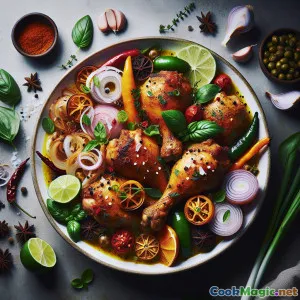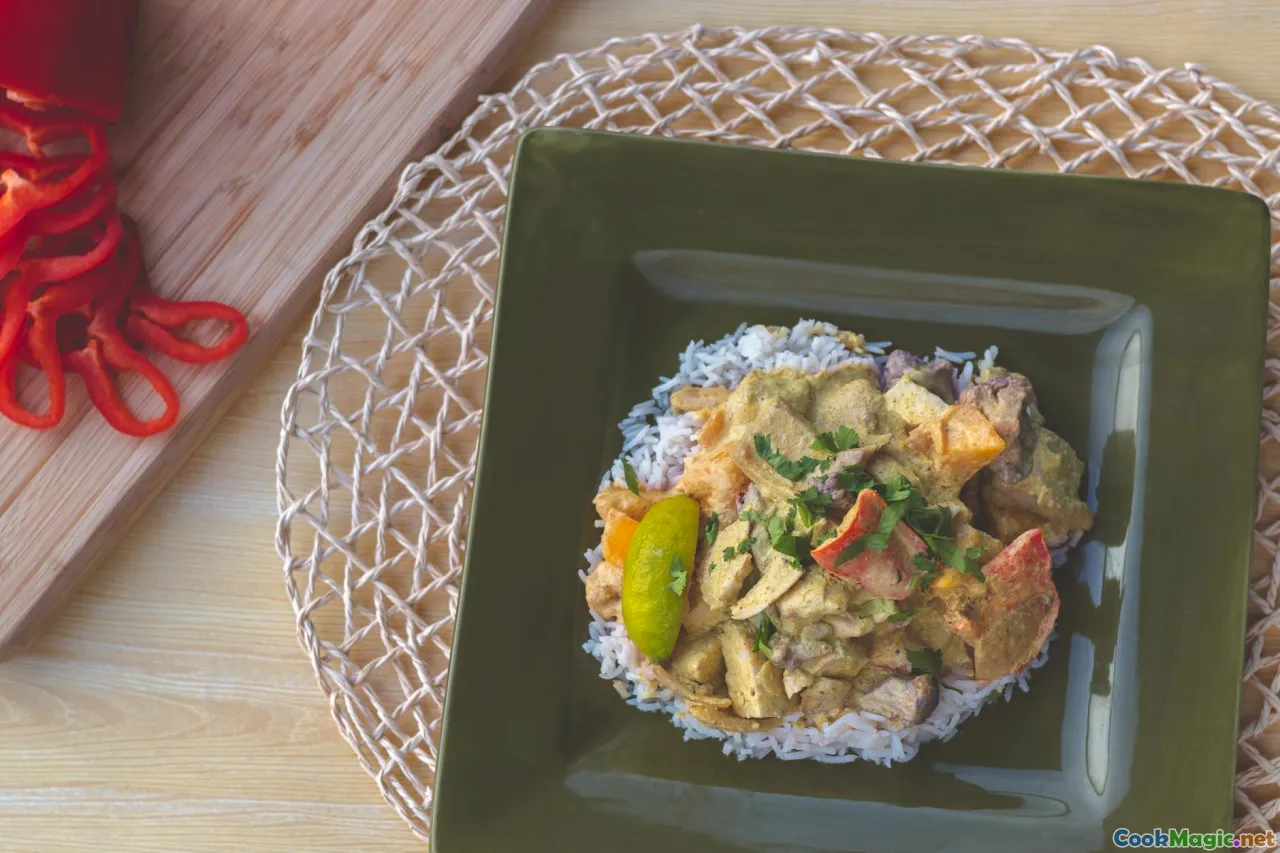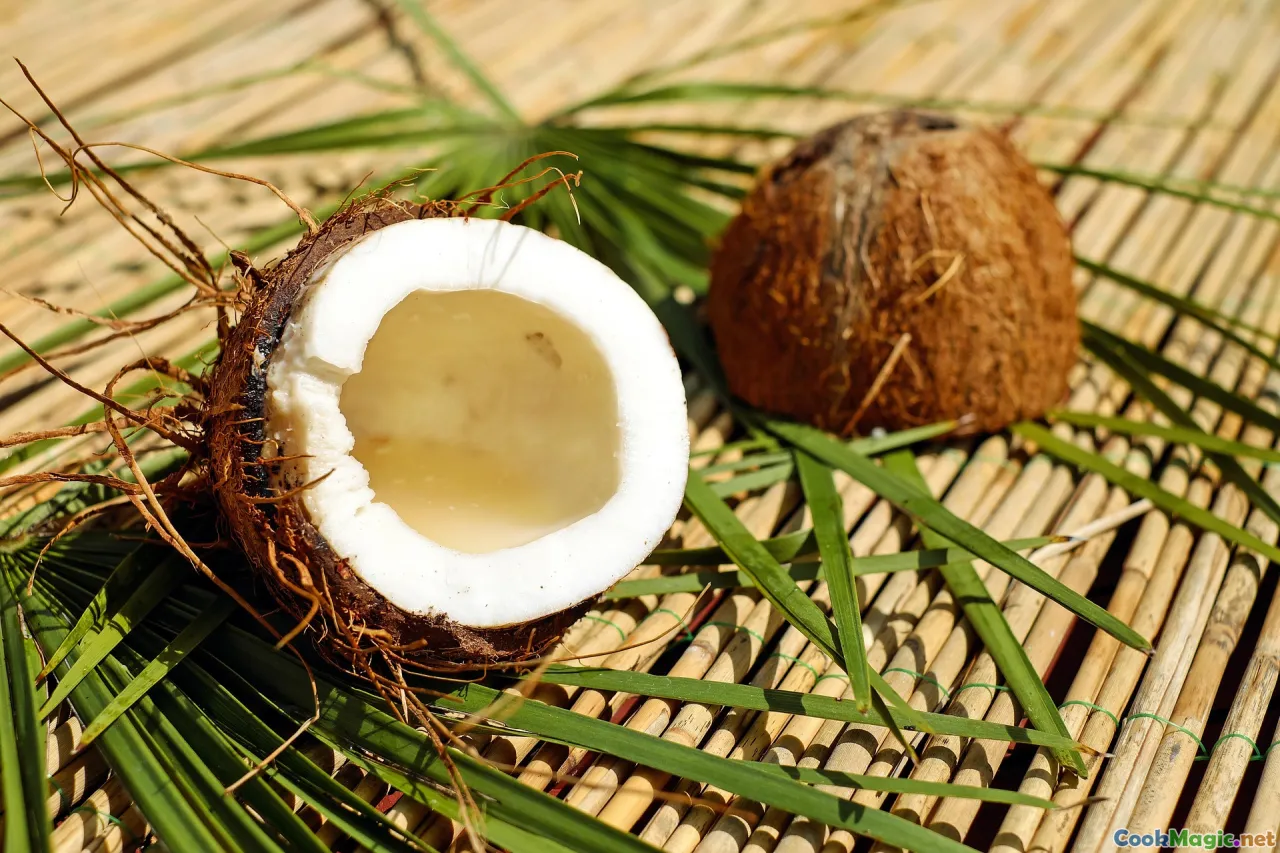
Coastal Palmwine Chicken with Coconut and Lime
(0 Reviews)0
354
November 10, 2025
Report a Problem
Ingredients
-
1200 grams Bone-in chicken thighs and drumsticks
(Skin-on for better browning and flavor)
-
300 ml Fresh palm wine
(Traditional; use dry, slightly fizzy palm wine if possible)
-
400 ml Coconut milk
(Full-fat for a silky sauce)
-
1.5 tbsp Red palm oil
(Adds color and earthy depth; substitute neutral oil if needed)
-
3 tbsp Lime juice
(Freshly squeezed for brightness)
-
1 tsp Lime zest
(Adds perfumed citrus lift)
-
5 cloves Garlic (minced)
(Crush to release oils)
-
2 tbsp Fresh ginger, grated
(Peel for a cleaner flavor)
-
1 piece Scotch bonnet pepper, finely chopped
(Wear gloves; adjust to heat preference)
-
1 large Onion, thinly sliced
(Yellow or red onion both work)
-
2 tsp Fresh thyme leaves
(Sub with 1 tsp dried thyme)
-
2 leaves Bay leaves
(Fragrant backbone for the braise)
-
1 tsp Smoked paprika
(Enhances subtle smokiness)
-
2 tsp Sea salt
(Season to Taste)
-
1 tsp Black pepper
(Freshly ground for best aroma)
-
1 tbsp Fermented locust beans (iru), rinsed
(Deep umami; omit if unavailable)
-
0.5 cup Fresh basil or scent leaf, chopped
(Scent leaf is traditional; basil is a good stand-in)
-
2 stalks Spring onions, sliced
(For garnish and freshness)
-
2 tbsp toasted coconut flakes
(Crunchy garnish)
-
120 ml Water or low-sodium stock
(Adjust for desired sauce thickness)
(Skin-on for better browning and flavor)
(Traditional; use dry, slightly fizzy palm wine if possible)
(Full-fat for a silky sauce)
(Adds color and earthy depth; substitute neutral oil if needed)
(Freshly squeezed for brightness)
(Adds perfumed citrus lift)
(Crush to release oils)
(Peel for a cleaner flavor)
(Wear gloves; adjust to heat preference)
(Yellow or red onion both work)
(Sub with 1 tsp dried thyme)
(Fragrant backbone for the braise)
(Enhances subtle smokiness)
(Season to Taste)
(Freshly ground for best aroma)
(Deep umami; omit if unavailable)
(Scent leaf is traditional; basil is a good stand-in)
(For garnish and freshness)
(Crunchy garnish)
(Adjust for desired sauce thickness)
Nutrition
- Servings: 4
- Serving Size: 1 plate (350g)
- Calories: 620 kcal
- Carbohydrates: 0 g
- Protein: 44 g
- Fat: 40 g
- Fiber: 3 g
- Sugar: 4 g
- Sodium: 780 mg
- Cholesterol: 165 mg
- Calcium: 55 mg
- Iron: 3.1 mg
Instructions
-
1 - Build the marinade:
In a bowl, whisk palm wine, lime juice, half the coconut milk (200 ml), garlic, ginger, Scotch bonnet, thyme, smoked paprika, 1.5 tsp salt, and black pepper.
-
2 - Marinate the Chicken:
Pat chicken dry. Score thick parts. Pour marinade over chicken and add onion slices. Toss, cover, and marinate 20 minutes (or up to 12 hours refrigerated).
-
3 - Brown for flavor:
Heat red palm oil in a wide pot over medium-high. Shake marinade from chicken (reserve marinade). Sear chicken in batches until golden on both sides.
-
4 - Deglaze and layer aromatics:
Reduce heat to medium. Add reserved onions from marinade to the pot; sauté 1–2 minutes. Deglaze with 60 ml palm wine (from measured 300 ml if reserved) or a splash of water, scraping brown bits.
-
5 - Start the braise:
Return chicken to the pot. Pour in remaining marinade, add bay leaves and iru (if using). Bring to a lively simmer.
-
6 - Coconut finish:
Stir in remaining coconut milk and 120 ml water/stock. Cover and simmer gently 15 minutes; uncover and simmer 5 minutes more to reduce slightly.
-
7 - Glaze and char:
Transfer chicken to a foil-lined tray, spooning some thickened sauce over. Broil/grill on high 3–5 minutes to caramelize edges.
-
8 - Reduce sauce to silk:
Meanwhile, boil the pot sauce over medium-high until glossy and nappe-thick. Adjust salt, lime zest, and pepper to taste.
-
9 - Herb and garnish finish:
Return chicken to the pot or platter, coat with sauce, and shower with chopped basil/scent leaf, spring onions, and toasted coconut flakes.
In a bowl, whisk palm wine, lime juice, half the coconut milk (200 ml), garlic, ginger, Scotch bonnet, thyme, smoked paprika, 1.5 tsp salt, and black pepper.
Pat chicken dry. Score thick parts. Pour marinade over chicken and add onion slices. Toss, cover, and marinate 20 minutes (or up to 12 hours refrigerated).
Heat red palm oil in a wide pot over medium-high. Shake marinade from chicken (reserve marinade). Sear chicken in batches until golden on both sides.
Reduce heat to medium. Add reserved onions from marinade to the pot; sauté 1–2 minutes. Deglaze with 60 ml palm wine (from measured 300 ml if reserved) or a splash of water, scraping brown bits.
Return chicken to the pot. Pour in remaining marinade, add bay leaves and iru (if using). Bring to a lively simmer.
Stir in remaining coconut milk and 120 ml water/stock. Cover and simmer gently 15 minutes; uncover and simmer 5 minutes more to reduce slightly.
Transfer chicken to a foil-lined tray, spooning some thickened sauce over. Broil/grill on high 3–5 minutes to caramelize edges.
Meanwhile, boil the pot sauce over medium-high until glossy and nappe-thick. Adjust salt, lime zest, and pepper to taste.
Return chicken to the pot or platter, coat with sauce, and shower with chopped basil/scent leaf, spring onions, and toasted coconut flakes.
More About: Coastal Palmwine Chicken with Coconut and Lime
Coastal Palmwine Chicken: Story, Technique, and Tips
Coastal Palmwine Chicken brings the briny breeze and lively markets of West Africa right to your table. It marries the natural effervescence and tang of fresh palm wine with the creamy roundness of coconut milk, bright citrus, and herbaceous notes—resulting in a sauce that is both beachy and bold. This is comfort food with a festive soul, perfect for gatherings where hands inevitably reach back for a second piece of chicken to swipe through the glossy, sunset-colored gravy.
What Makes It Unique
- Palm wine’s gentle acidity does the heavy lifting in tenderizing the chicken while layering delicate fruitiness. As it reduces, it concentrates into a sweet-sour backbone that balances heat from Scotch bonnet.
- Red palm oil adds more than color; it brings a distinctly earthy, nutty note that anchors the coconut’s richness. If you’ve only used neutral oils for braises, the difference here is striking.
- The braise-and-char approach combines the juiciness of moist cooking with the flavor fireworks of grilling, giving you crisp edges and lacquered skin.
Flavor Architecture
- Base: Aromatics (onion, garlic, ginger) and thyme build warmth.
- Acid: Palm wine and lime juice tenderize and brighten.
- Heat: Scotch bonnet offers citrusy heat; use sparingly or boldly.
- Body: Coconut milk provides silk and a gentle sweetness.
- Depth: Optional iru (fermented locust beans) adds savory bass notes.
- Finish: Lime zest and fresh scent leaf or basil lift everything at the end.
Technique Notes
- Marination Matters: Even 20 minutes makes a difference because palm wine’s acidity penetrates quickly. Overnight marination yields deeper seasoning and a more cohesive sauce.
- Brown the Chicken: Don’t crowd the pot. Browning develops fond—the caramelized bits that will become the sauce’s flavor treasure when deglazed.
- Simmer, Don’t Boil: A gentle braise keeps the chicken succulent and prevents coconut milk from splitting. If the pot gets too hot, add a splash of water and reduce the heat.
- Char for Contrast: A brief broil or grill after braising gives a smoky kiss and textural contrast without drying the meat.
- Reduce to Nappe: Aim for a sauce that coats the back of a spoon. Your cue is a glossy sheen and slow, heavy drips.
Ingredient Swaps and Sourcing
- Palm Wine: If fresh palm wine is unavailable, mix a dry, slightly sweet white wine with a teaspoon of palm sugar or light brown sugar and a few drops of cider vinegar to mimic tang and faint sweetness.
- Red Palm Oil: Substitute a neutral oil plus a pinch of annatto or smoked paprika for color, though the unique flavor of red palm oil is worth seeking out from African grocers.
- Scotch Bonnet: Habanero is a common stand-in with a similar fruity heat. For very mild, use half a pepper or remove seeds and membranes.
- Scent Leaf: Thai basil or Italian basil gives a close aromatic profile; mint can add brightness but use sparingly.
- Iru: Omit if you can’t find it, or add a teaspoon of fish sauce for umami.
Serving Suggestions
- Classic Sides: Steamed white rice, coconut rice, or garri (eba) to soak up the sauce.
- Plantains: Pan-fried ripe plantain slices amplify the dish’s caramel notes.
- Greens: Lightly sautéed spinach or ugu (pumpkin leaves) with garlic and a squeeze of lime.
Make-Ahead, Storage, and Reheating
- Make-Ahead: Marinate the chicken up to a day ahead. Cooked chicken improves after a rest; the flavors marry overnight.
- Storage: Refrigerate in an airtight container for up to 3 days. Freeze for up to 2 months.
- Reheat: Warm gently on the stovetop with a splash of water or coconut milk to loosen the sauce. Re-crisp under a broiler for 2–3 minutes if desired.
Cultural Notes
Palm wine flows through celebrations and daily life across coastal West Africa—from Nigeria and Ghana to Sierra Leone and Benin. It symbolizes hospitality and connection, often shared communally in calabashes. Cooking with it is both practical and poetic: it preserves, tenderizes, and transforms. This recipe, while modern, nods to that heritage—honoring the region’s coastal trade winds that brought spices, coconuts, and cooking methods together over centuries.
Chef’s Tips for Success
- Balance is key: Taste at the end and fine-tune with salt, a squeeze more lime, or a splash of palm wine if you want extra tang.
- Control the heat: Scotch bonnet’s strength varies. Add half first; you can always add more.
- Skin-on, bone-in: Essential for juiciness and flavor extraction during the braise.
- Garnishes are not vanity: Fresh herbs and lime zest brighten the rich sauce and wake up your palate between bites.
Pairings
- Drinks: A chilled, lightly sparkling palm wine if available, or a crisp lager. For wine, try a dry Riesling or Chenin Blanc with enough acidity to cut through the richness.
- Dessert: Fresh pineapple with lime and a pinch of chili salt echoes the dish’s tropical-citrus profile.
With its sunlit sauce and layered aromatics, Coastal Palmwine Chicken is the kind of dish that seduces quietly and then stays with you—like the echo of a shoreline drum, steady and warm, calling you back for one more taste.


















